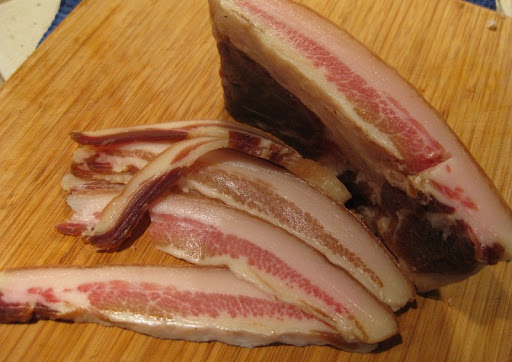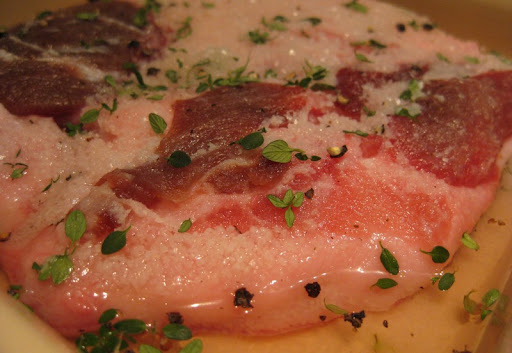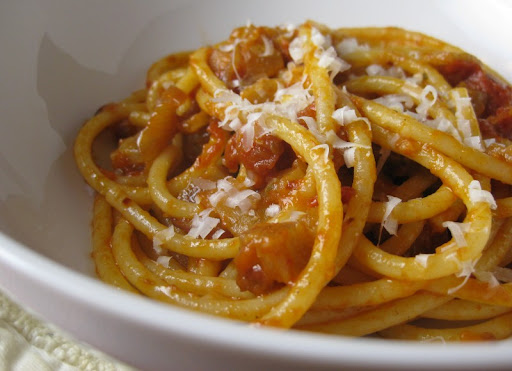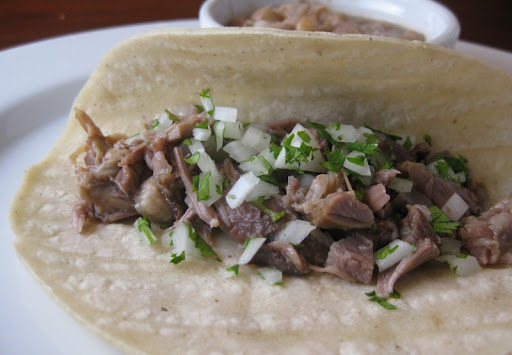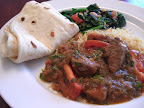
While we were in Oaxaca, we fell head-over-heels in love with the chorizo there. Here in San Diego, despite the wide availability of Mexican food products in general, we've been unable to find a chorizo that tastes as good.
The chorizo we bought from our local carniceria in Oaxaca had a deeper color to it and a more complex and tangy flavor. Plus, we missed the pretty bolitas of chorizo we would see hanging amongst other lovely bits of meat:

Our solution to this problem (which will come as no surprise to regular readers of this blog) was that we would have to try to make it ourselves.
After a bit of experimentation, our recipe is something of a combination of a version from The Food and Life of Oaxaca , by Zarela Martínez and one from Rick Bayless' Authentic Mexican
, by Zarela Martínez and one from Rick Bayless' Authentic Mexican .
.
At its base, this chorizo starts like most pork sausages: a mixture of ground pork meat and fat (we use shoulder and belly). Where it differentiates itself is in the seasoning. The dark color comes from lots of chile - in both amount and variety. For this batch we used ancho, paprika, chipotle, guajillo and cayenne. Most of it is for depth of flavor, but it also adds a nice bit of heat.
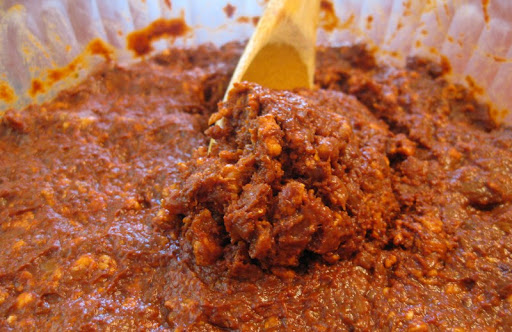
The taste gets an acid kick from some cider vinegar and is rounded out with herbs (thyme and oregano) and spices (peppercorns, cinnamon, clove and nutmeg).
Into the sausage stuffer it goes:

And the "after" shot, with the lovely, fatty, burnished-orange afterglow from the chorizo meat.
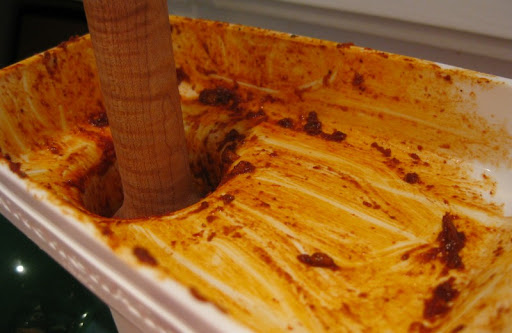
We were very pleased at how the bolitas of chorizo turned out:
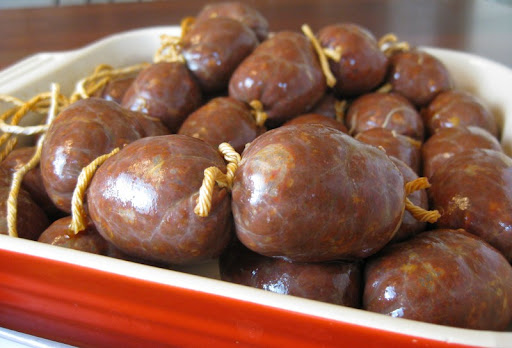
After stuffing it was into the magic fridge to hang for a couple of days (that's some saucisson sec hanging in the background).

After it has tightened up a bit it is ready to go. The uses are endless. Just grab a few bolitas, toss them in a frying pan and cook them until they burst and spill out.
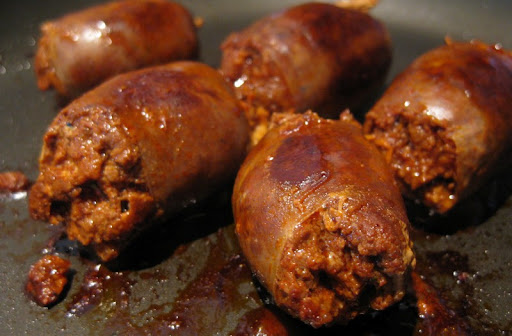
Then add it to your dish of choice. We have a growing number (such as our recipe for Chori-Migas), but one of the simplest and most satisfying is to use it as a topping for some breakfast memelitas:

The day just starts off better when it starts off with some chorizo.
Oxacan-style Chorizo
You'll want about 2 1/2 oz of whole dried chiles (anchos, guajillo, chipotle or another mixure of fairly mild chiles). If using ground chile, substitute with about 1 1/2 oz. Keep the meat very cold at all times to improve the grinding and stuffing process.
6-7 ounces pork belly
9-10 ounces pork shoulder
2 or 3 medium ancho chiles, seeded and stemmed
1 guajillo chile, seeded and stemmed
1 to 2 dried chipotle chiles, seeded and stemmed
1/2 teaspoon black peppercorns
2 whole cloves
1/2 inch cinnamon stick (preferably canela)
3/4 teaspoon mexican oregano or marjoram
1/4 teaspoon thyme
generous pinch ground nutmeg
2 teaspoons paprika
1/2 teaspoon cayenne pepper
2 1/4 teaspoons kosher salt (mortons)
1 garlic clove, whole
1 garlic clove, minced
1/3 cup cider vinegar
water for soaking chiles
Hog casings
Kitchen twine
Cut the pork belly and shoulder into finger shaped pieces 2 to 3 inches long (remove any tough or stringy gristle). Coarsely grind the meat with a meat grinder. Place into the refrigerator to chill while you prepare the seasonings.
Tear the chiles into large, flat pieces. In a hot, dry pan, quickly toast the chiles a few pieces at a time, just until they start to change color and/or blister. This will only take a few seconds - do not over cook or burn. Place the toasted chiles into a bowl, cover with hot water and soak until softened, about 20 minutes.
Place the peppercorns, cloves, cinnamon, oregano and thyme into a spice grinder and grind finely. If you do not have a spice grinder, add these to the blender in the next step, but run it much longer.
Drain the chiles (reserving the liquid) and place into a blender along with the ground spice mixture, the nutmeg, paprika, cayenne, salt, and 1 garlic clove. Add the cider vinegar and 5 tablespoons of the reserved chile soaking liquid, then blend until smooth.
Using a large spoon, thoroughly mix the seasoning and minced garlic into the ground meats. It will be quite loose. Cover and refrigerate overnight.
Prepare hog casings for stuffing by soaking in warm water at least 30 minutes. Change the soaking water and run fresh water through them to remove traces of salt. Stuff the meat into the casings, but leave each piece of casing unstuffed at least 6 inches at each end. Keep the long sausage link quite loose rather than densly packed (if too tight, the casing may burst while creating the small links). Starting in the center and working toward the ends, use kitchen twine to tie the sausage into short, tight rounds the size of a golf ball.
Hang the links in a cool airy place (50-60 degrees) for 36-48 hours or until they have firmed up and are dry to the touch. Be sure to put a baking tray lined with paper towels underneath the sausage to catch the drips. Cut the finished sausage into shorter sets of links, then wrap in plastic and refrigerate or freeze until ready to use.
